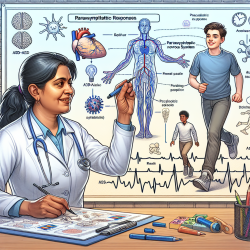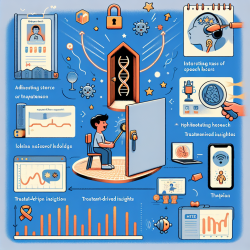Introduction
Autism Spectrum Disorder (ASD) presents unique challenges in social interactions, often resulting in elevated stress levels for those affected. A recent study titled Evidence for decreased parasympathetic response to a novel peer interaction in older children with autism spectrum disorder: a case-control study provides valuable insights into the physiological responses of children with ASD during peer interactions. This blog explores how practitioners can leverage these findings to enhance their therapeutic approaches and encourage further research in this area.
Key Findings
The study examined autonomic nervous system (ANS) responses, specifically focusing on parasympathetic (PNS) and sympathetic nervous systems (SNS) during social interactions. The researchers found that older children with ASD exhibited a blunted parasympathetic response, as indicated by respiratory sinus arrhythmia (RSA) measurements. This atypical regulation was associated with increased social difficulties and anxiety levels.
Implications for Practitioners
Understanding the physiological underpinnings of social stress in ASD can guide practitioners in tailoring interventions. Here are some strategies to consider:
- Incorporate Biofeedback: Using biofeedback techniques can help children with ASD become more aware of their physiological responses and learn to regulate them. By monitoring RSA, practitioners can provide real-time feedback and teach relaxation techniques to manage stress.
- Focus on Social Skills Training: Given the link between parasympathetic response and social difficulties, targeted social skills training can help mitigate stress during peer interactions. Role-playing and structured social activities can build confidence and reduce anxiety.
- Personalize Interventions: Recognize the diversity within ASD and personalize interventions based on individual stress responses. Consider factors such as age, social functioning, and specific anxiety triggers when designing therapeutic plans.
Encouraging Further Research
While this study provides valuable insights, it also highlights the need for further research to understand the developmental factors influencing stress responses in ASD. Future studies could explore:
- The long-term impact of chronic social stress on physiological and psychological outcomes in ASD.
- The role of other physiological systems, such as the hypothalamic-pituitary-adrenal (HPA) axis, in social interactions.
- Interventions that can enhance parasympathetic regulation and improve social engagement in children with ASD.
Conclusion
The study underscores the importance of understanding physiological responses in ASD to improve therapeutic outcomes. By incorporating these findings into practice and encouraging further research, practitioners can better support children with ASD in navigating social interactions.
To read the original research paper, please follow this link: Evidence for decreased parasympathetic response to a novel peer interaction in older children with autism spectrum disorder: a case-control study.










